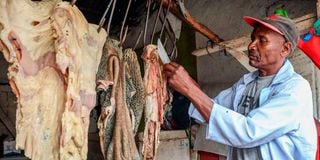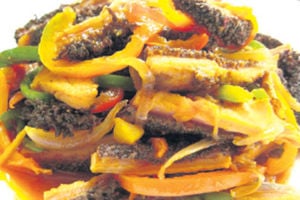
Peter Mwangi during an interview at his workplace butchery in kibera Nairobi on September 18, 2024.
The consumption of matumbo or tripe has risen in the past years, despite concerns from nutritionists that it has lower nutritional value compared to other meats, and is associated with an increased risk of obesity and cardiovascular diseases.
A majority of the sellers say the harsh economy has affected household spending, pushing up consumption of tripe. Data from the latest Economic Survey shows that volumes consumed stand at 74,000 metric tonnes.
Danson Wanderi, 42, a butcher in Nairobi’s Kibera, attests to the growing demand at his butcher shop, which is also strategically located next to a bar.
“Over the past few months, I’ve seen a steady increase in the sale of tripe,” says Mr Wanderi. “On average, I sell around 25 kilos daily, which adds up to roughly 160 kilos a week. By the end of each business day, most of the stock is sold out, and I restock from a nearby slaughterhouse daily.”
The low price of tripe, at Sh300 per kilo compared to beef which goes from Sh760 to Sh1,200 for special cuts, makes it more affordable to Kenyan buyers.
“Many customers are complaining about the tough economy,” says Mr Wanderi, “But those who do come by, especially after drinking alcohol, often believe that eating tripe helps to reduce the unpleasant feeling of drunkenness.”
In Nairobi’s Makina, Thomas Oduor also operates a butchery.
Over the years, Mr Oduor has built a loyal clientele. He estimates he sells between 20 and 25 kilos of tripe daily.
“My customers are a mix of regulars and passersby,” Mr Oduor says.
“Tripe is affordable here, starting at Sh320 per kilo, which makes it a popular choice, especially among low-income earners.”
In addition to tripe, Mr Oduor stocks other organ meats such as liver, lungs, kidneys, and heart, which are also popular.
He even offers a boiling service for those who prefer to buy ready-to-eat tripe but lack the time to prepare it themselves.
“Many people think tripe takes too long to cook, so they pay an extra Sh50 for us to boil it for them,” he adds.
Does it have any nutritional value?
While the demand for tripe continues to soar, pushing its price to Sh314 per kilo compared to Sh250 per kilo five years ago, nutritionists warn about the health risks associated with high intake.
Kepha Nyanumba, a Nairobi-based nutrition expert, explains that although tripe is an affordable source of protein, it carries significant health risks, especially when consumed in large quantities.
“Tripe is an animal protein that is considered less nutritious compared to other protein options like beef, seafood, or chicken. However, it does contain collagen, which is beneficial for skin elasticity and joint repair,” he says, adding, "If it must be eaten, it should be consumed in moderation due to the health risks it poses."
“Tripe contains high levels of cholesterol, which can be dangerous for people who are already predisposed to conditions like heart disease or stroke,” he says.
“We live in a time when many people are battling high cholesterol levels, and consuming too much tripe could exacerbate these conditions.”
Mr Nyanumba also stresses that tripe is rich in saturated fats, which contribute to weight gain and increase the risk of lifestyle diseases such as diabetes and hypertension. In addition, tripe contains purines, compounds that can lead to the overproduction of uric acid in the body, potentially triggering gout flare-ups, a disease that causes pain and swelling in joints.
“People with conditions like gout need to be especially cautious about how much tripe they consume because purines can raise uric acid levels in the body,” says Mr Nyanumba.
“Tripe also takes longer to digest, which can worsen digestive disorders such as gastritis or constipation.”
Vitamin B12 and zinc
Despite these concerns, Mr Nyanumba debunks the myth that tripe has zero nutritional value. Albeit lower than the other meats, it is rich in vitamin B12 and zinc. However, he stresses that tripe must be properly cleaned and cooked to ensure it is safe for consumption.
“Thorough cleaning is essential when preparing tripe,” he says.
Kenyans love deep-fried matumbo, but Mr Nyanumba says you should cut it into small pieces and avoid deep frying, as that adds unnecessary fats. Instead, opt for boiling or stewing, and you can enhance the flavour with natural spices.”
For those looking for healthier alternatives, Mr Nyanumba suggests opting for lean cuts of meat or plant-based proteins such as beans, green grams, and lentils.
“These options provide the same nutritional benefits as tripe without the health risks associated with saturated fats and cholesterol,” he says.
Joy Ouma, a registered clinical nutritionist and dietitian at Aga Khan University Hospital, adds her perspectives on the rising consumption of tripe.
While offal (entrails and internal organs of an animal), including tripe, is often considered less desirable, she explains that it offers some nutritional benefits.
“Offal, such as liver and kidneys, are higher in specific nutrients like vitamins B12 and A, along with minerals like iron and folate. While beef and chicken may offer different protein content, offal can provide these essential micronutrients,” she says.
However, Ms Ouma warns about the health risks of consuming organ meats like tripe, particularly if they are not properly sourced or prepared.
“Improper handling can lead to foodborne illnesses due to bacterial contamination from pathogens like salmonella or E. coli, especially in undercooked organ meats. It’s critical to ensure proper hygiene and preparation to avoid these risks,” she says.
Nutritional value of tripe
Ms Ouma notes that besides vitamin B12, zinc and iron, tripe provides other essential nutrients such as selenium, which is an important antioxidant.
“Tripe can contribute to a balanced diet, but it's important to consider that liver and kidneys offer even higher nutrient levels, which makes them a better choice if you're looking for a nutrient boost,” she says.
Ms Ouma also refers to a 2020 study published in the Journal of Nutrition, which supports the inclusion of offal in diets due to its high nutrient density.
“The research shows that while offal is nutrient-rich, moderation is key to avoid excess cholesterol and related health risks,” she explains.
To maintain a balanced diet, Joy recommends that those who include offal in their meals adhere to the six principles of nutrition—adequacy, balance, calorie control, nutrient density, variety, and moderation.
“It's important to alternate between different types of offal and combine them with a variety of other foods to ensure a well-rounded diet,” she advises.
Alcohol recovery myth
Regarding the belief that eating tripe after drinking alcohol helps with recovery, Ms Ouma is cautious.
“There isn't enough scientific evidence to support this claim. While proteins are important for recovery, hydration and balanced nutrition are far more effective at alleviating hangover symptoms,” she says.





